As the former technical director of Barcelona’s famed La Masia, Albert Puig has experience developing talent such as Riqui Puig and Ansu Fati. He was the director of the Catalans’ academy from 2010-2014 before leaving the club to pursue other football jobs, including being Domènec Torrent’s assistant at NYCFC in MLS. Puig took charge of his own squad by joining Albirex Niigata, who compete in the J2 League. There, he utilises his positional play tactics, similar to Barcelona or Bayern Munich, to guide the club on the pitch.
This tactical analysis will examine the tactics Puig uses at Albirex Niigata. The analysis will look at his positional play philosophy, including the team’s search for superiority throughout their build-up play, their progressions through the middle third, as well as how they look to defend and press.
Superiority in the build-up
One of Puig’s main goals in the build-up is to create a numerical superiority in order to progress the ball. This ensures that Albirex Niigata always have at least one additional man, and Puig expects his players to be able to solve the situation. The first example comes from their game against Ehime FC, where their goalkeeper, Masahiro Okamoto, joins his teammates in the middle third to help create the numerical advantage.
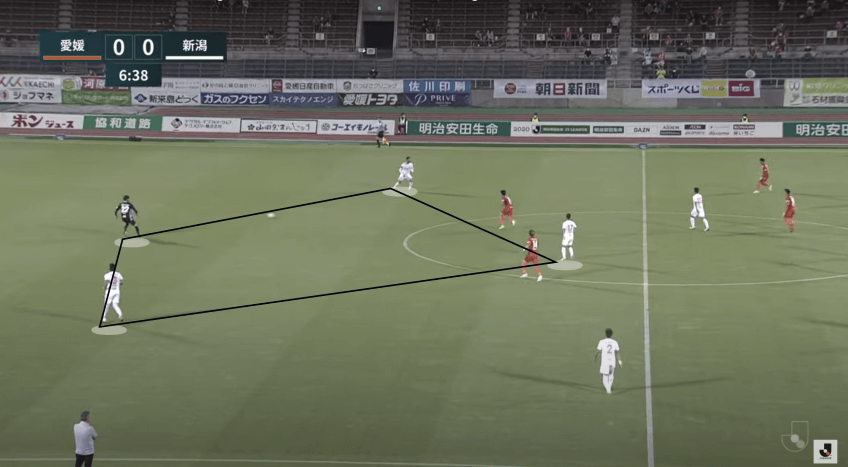
Okamoto helped be the additional player against the line of two opposing strikers. His willingness to step forward forces the strikers into deciding who to press and when. In this instance, Okamoto wasn’t pressed; instead, they waited for him to play his centre-back before providing pressure. From there, Daiki Nishioka was able to play a vertical ball to a player positioned directly between two opponents.
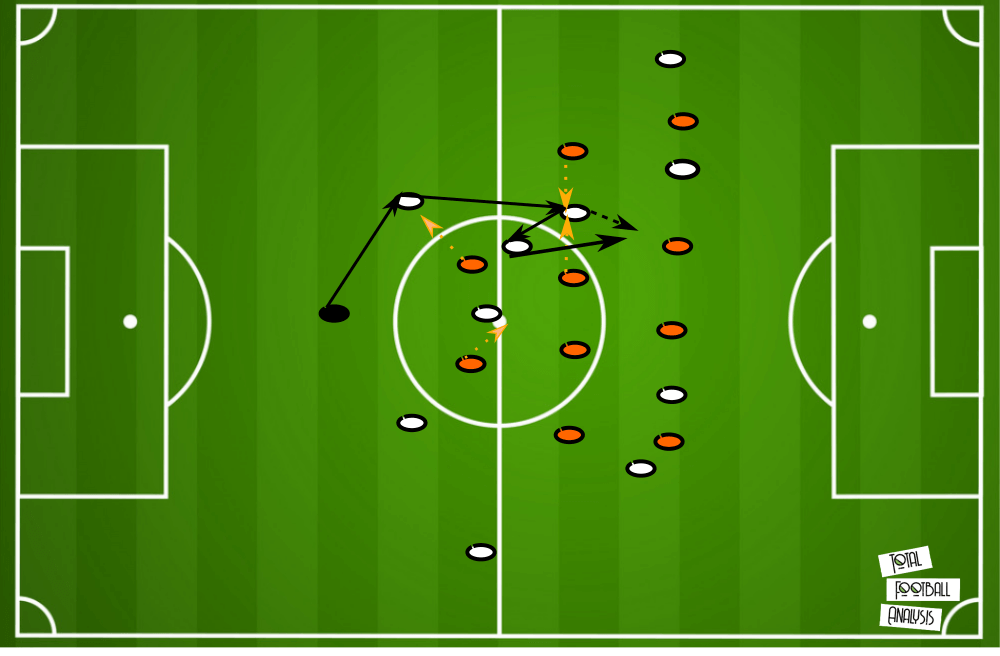
Positioning is incredibly important in this build-up as well. When Okamoto played the ball to his centre-back, the strikers moved to pressure, with one pressing the ball carrier and the other covering one of the pivots. The centre-back who now had the ball looked to play a vertical pass. This pass is not intended as a ball to progress, but rather to move the opponent. It’s the first part of a third-man move, and the defenders react accordingly. Both collapse on the ball, allowing the midfielder (Yoichi Naganuma) to lay his pass off to his holding midfielder before running into the space that his opponent just left. This third-man action is used consistently throughout Puig’s teams, regardless of where they are on the pitch.
Against Kyoto Sanga FC, Albirex Niigata used a similar diamond structure from a goal kick. Once again, similar principles were in play: their goalkeeper (Ryosuke Kojima) used his initial pass to his holding midfielder as a wall pass, getting the ball back with some pressure, leading to the situation below.
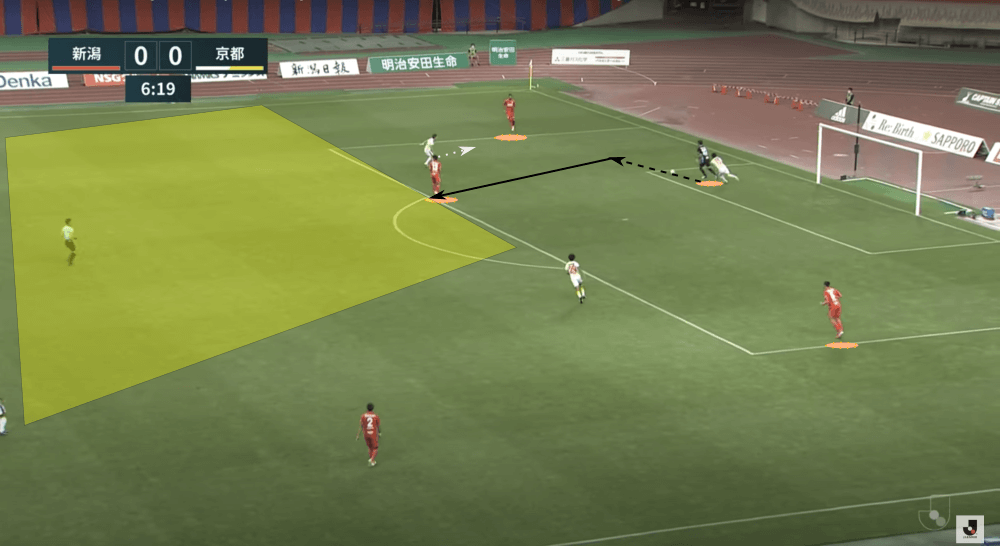
Kojima had the confidence to take his first touch past the pressing striker, creating room for himself to deliver a pass. Kyoto Sanga’s forward pressed the centre-back, opening up space for him to pass to Gonzalo González, who was the midfielder at the top of the box. The other important part of the build-up to recognise is the space created for González in this instance. Albirex Niigata’s other midfielders were positioned much higher up the pitch, dragging their defenders with them. This created more room to receive, but also created the necessary space to receive a long ball if Kojima had to end up sending it long.
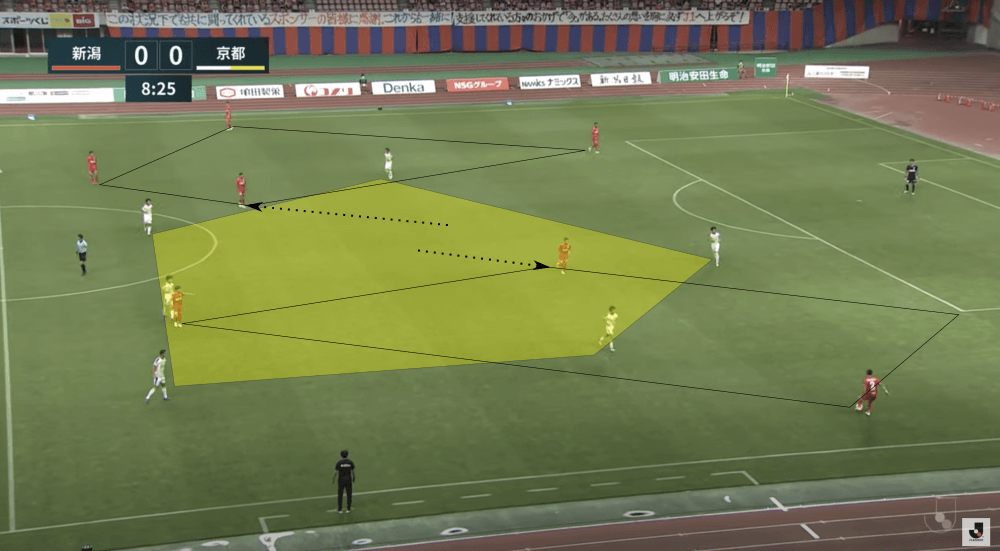
Above is one final image to highlight with Puig’s build-up, which is the positioning of their players. First, the outside backs provide the width with four midfielders in the centre of the pitch. Albirex Niigata often play in a 4-2-2-2 formation, allowing their outside backs to provide the width most consistently. This allows for a central overload. Albirex Niigata use those central players to pin opponents and create space to progress forward.
As the ball moves from left to right, their two holding midfielders rotate throughout the centre of the pitch to provide support and progression opportunities. The multiple players at multiple heights allow for diamonds to form, meaning if a ball is played into the farthest point of the diamond, the man should have two clear passing options without having to try and turn under pressure.
Progression through the middle third — all about space
Puig’s teams look to progress the ball into the middle third with a free man so that they can bring that numerical advantage that is inherent in the initial third (almost always because of the goalkeeper) into the middle. This obviously becomes tougher when teams are less willing to press and more willing to set up their defensive lines of pressure in the middle third. This results in Puig’s team’s continual search for a free man available in space in order to again progress the ball forward. The free man can be identified however is necessary, although Puig’s side is typically most successful when attracting pressure.
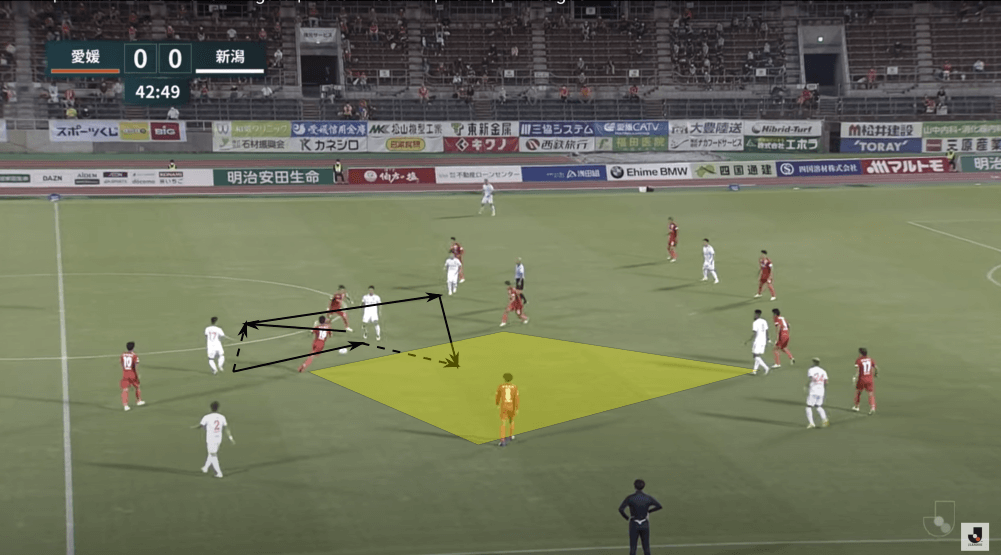
One example of them attracting pressure is shown above. This is an incredibly similar pattern that was highlighted in their build-up. They initially play a pass into a teammate positioned between two defenders, attracting their pressure as they do. The ball then goes back to the original passer, who can pick out a new target.
In this instance, the midfielder finds a man facing his own goal. Instead of turning, the man plays a pass back into the (relatively) large amount of space that has opened up back from where the ball came. From there, Albirex Niigata can progress forward.
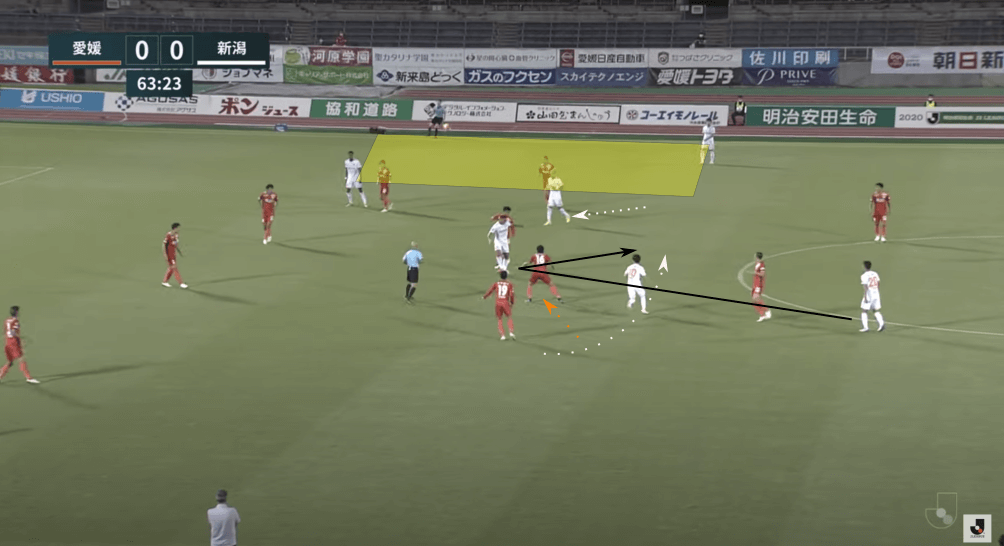
Albirex Niigata also look to utilise the space available on the wings. In the instance above, they again attract pressure in the centre of the pitch, relying on third-man actions to find the open man who can pick out a target from there. When the ball goes into their midfielder’s feet, they have another one running underneath him, again not requiring him to turn. The initial pass attracts the attention of all the defenders, and all he needs to do is lay it off for his teammate. A key part of this movement was the run by Romero Frank, who looked to occupy space in the centre of the pitch. This opened up even more room on the flank for the right-back to receive the ball and deliver his forward cross into the box.
The search for a free man in space can also lead to large switches of the field, looking to find a numerical or qualitative advantage. This again usually stems from the team attracting pressure on one side of the pitch.
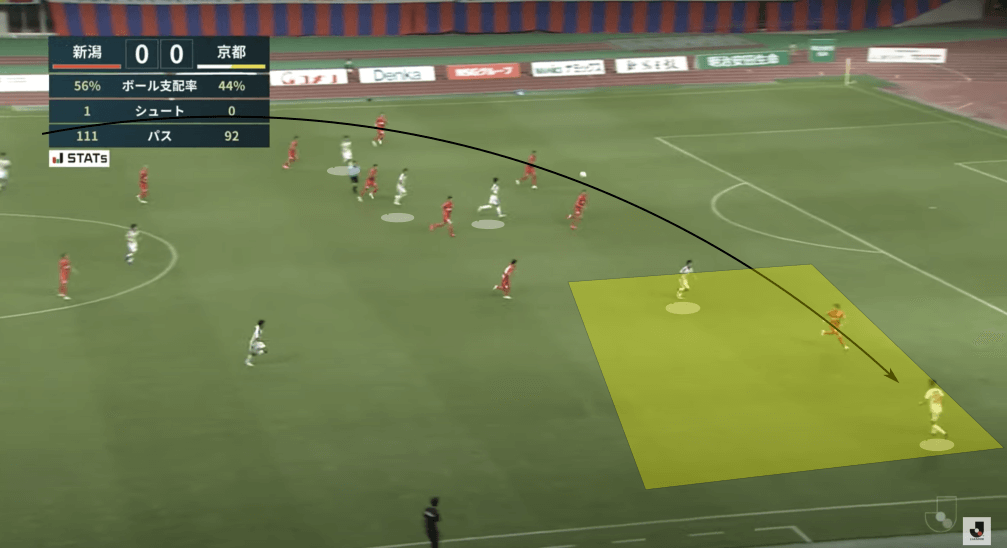
In the image above, Albirex Niigata initially moved the ball from the right side of the pitch to the left side. On the left side, they had three men between the two lines of pressure, drawing the attention of the defenders with their positioning. With no one pressuring the ball, the Albirex Niigata defender saw a numerical advantage and played a big switch to the right flank. Awaiting the pass were two of their players against one Kyoto Sanga player. While they weren’t able to make much of the opportunity, a smart diagonal run and a well-timed pass could have gotten Albirex Niigata into the penalty area.
If opponents sit deep in their block, Albirex Niigata will look to manipulate the back line. In the image below, they find a 2-3-5 shape, meaning that they’ve created numerical equality with the last line of defence. This is not ideal for the defending team.
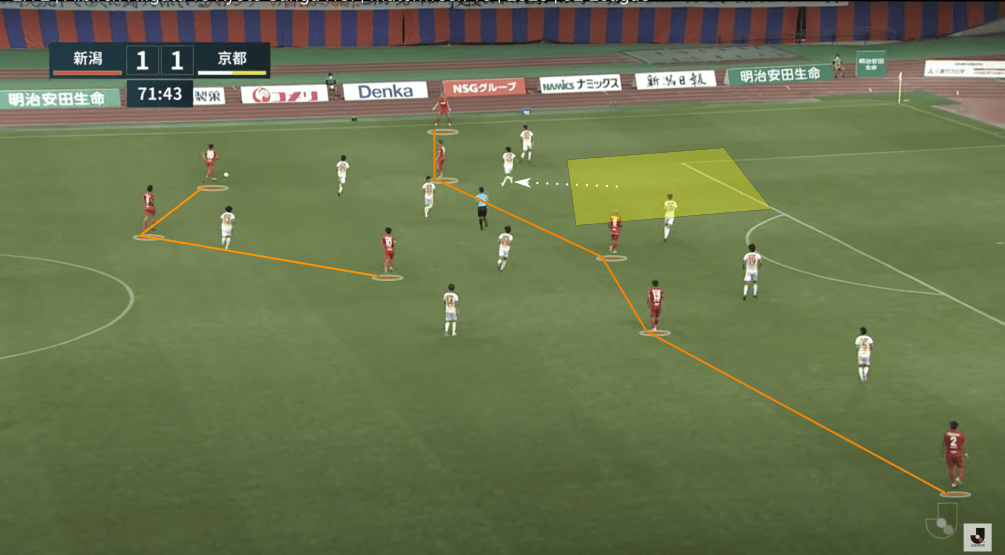
The reason it’s not ideal is clear; every defender has a man he is responsible for. If that man moves or checks into space, he probably needs to be followed. This is exactly what the Kyoto Sanga player did in the instance above and it created a massive amount of space for players next to him to run in behind the defence.
While they weren’t able to recognise this and take advantage of it, the fact that they’re able to create that much space that close to the goal points to the fact that Puig’s positional play is working quite well.
Pressing and defensive set-up
Albirex Niigata defend on the front foot, looking to press their opponents and regain possession as quickly as possible. This means that they are willing to commit men higher up the pitch. Puig’s pressing formation changes depending upon the opponent, but he typically uses his two forwards to provide pressure and cover the opponent’s defensive midfielder.
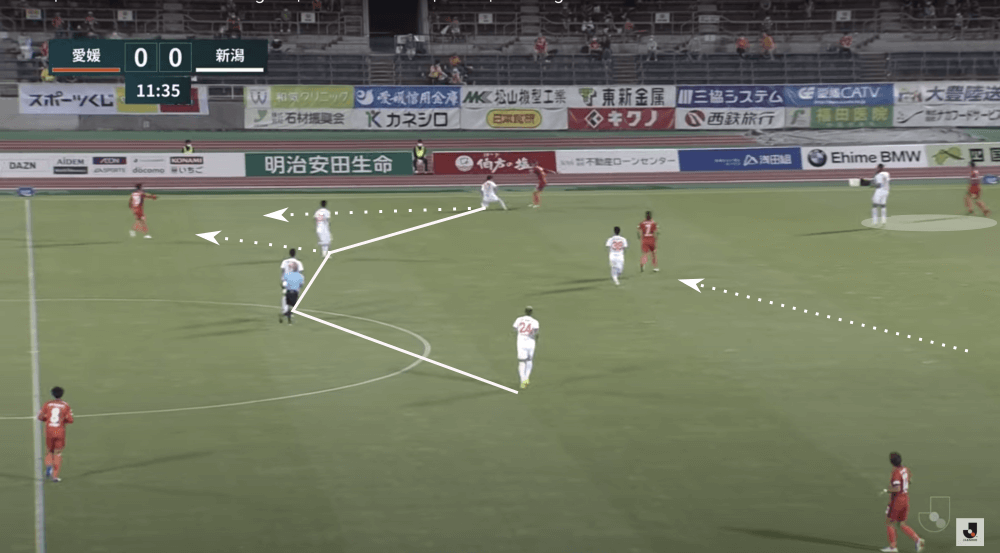
In the instance above, Albirex Niigata are set up in a 4-4-2 press with their forward pressing the man on the ball while the other tracks back. Their opponent didn’t seem prepared for the press, as they had many men behind the ball. The role of the central midfielders is important too since their initial job is to protect the space in the centre of the pitch and prevent interior passes. Once a pass is made though, they are allowed to pressure.
In the image above, as soon as the ball is played, both the wide midfielder, defensive midfielder, and left-back (not included in the image) collapse on the pass. Because their opponent had allowed them to obtain superiority in the middle of the pitch, Albirex Niigata set this trap and won the ball back quickly, allowing them to attack on the transition.
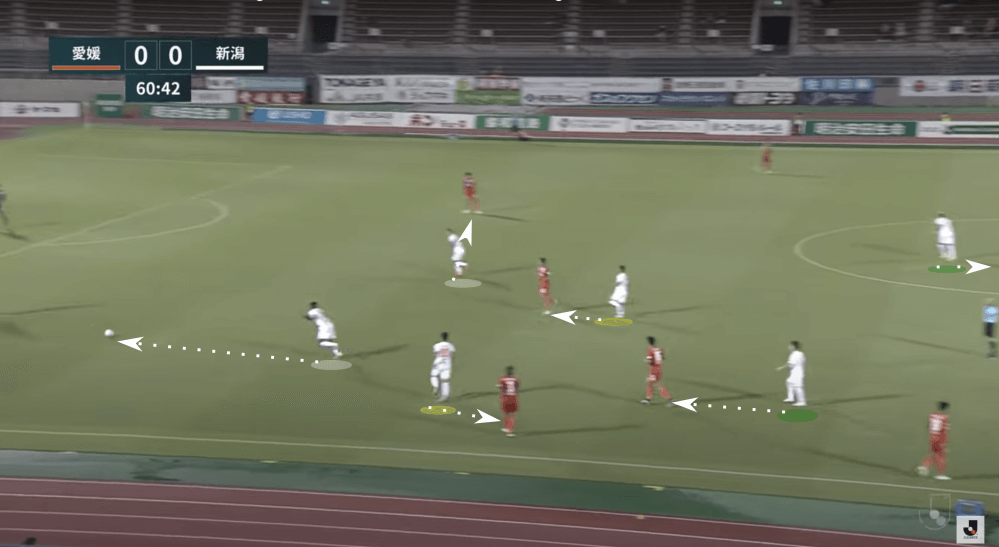
In the instance above, you can see their flexibility in pressing. This is a more man-oriented 4-2-2-2 press with the pairs of positions highlighted by the different colors underneath the players. This is obviously much more compact than the previous image, but their opponent is still under an immense amount of pressure as they try to work the ball back. The forwards press the centre-backs while the two forward midfielders follow their men as they try to provide support to the centre-backs. The holding midfielders can mark the near-side outside back if necessary and the additional midfielder. The use of defending with covershadows, particularly in the midfield, is important because it allows Albirex Niigata to defend space while again preventing interior passes from occurring, meaning teams need to build down the flanks initially if they want to get forward.
If teams do get past their press, Albirex Niigata are more than prepared to commit tactical fouls, particularly if they’ve committed men forward. This slows down the opponents progression and allows them to set up defensively. When they set up defensively, their midblock is typically a 4-4-2 which can turn into a 5-3-2 depending on the opponent’s actions. Either way, the defensive shape is entirely compact, covering just over half the pitch with their players.
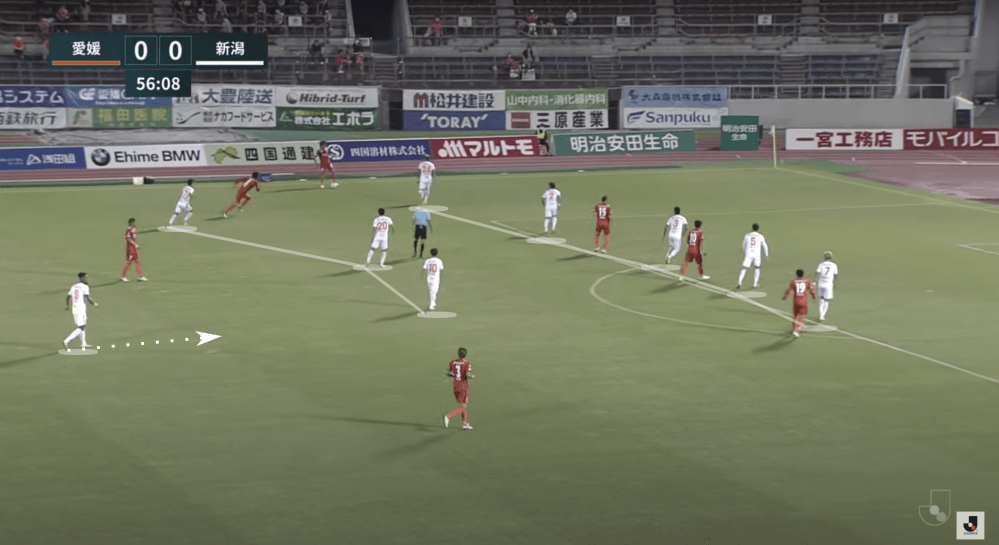
In the image above, their opponent was attacking down the left flank, causing their right attacking midfielder (as they were playing in a 4-2-2-2) to drop down and defend on the back line. This also allowed them to have a numerical advantage as Ehime FC had three men committed in the centre of the pitch. The positioning of the left side of the defence also highlights how narrow they defend. Their left-back was in the central channel, nearly in the middle of it. Puig’s forward also dropped down to prevent any potential ball movement to that side, essentially isolating Ehime on the left side.
The final thing to highlight within their defensive structure is the aggression that embodies their overall style of play. In the image below, Ehime FC were recycling possession. Puig’s team was stepping up, continuing to keep their 5-3-2 shape as their opponents were still overwhelming the left side of the pitch.
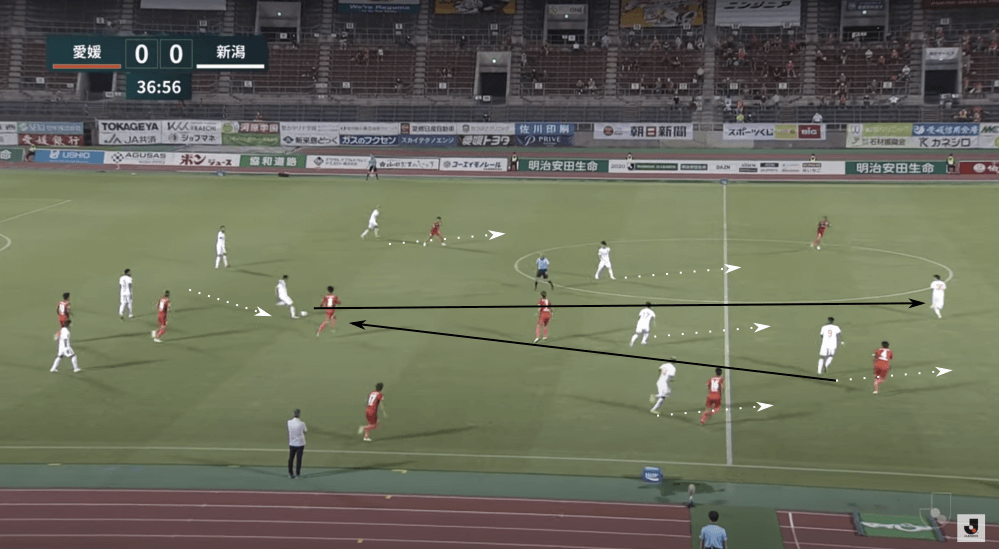
Ehime looked to play a diagonal ball that didn’t find its intended target. Albirex Niigata’s free man on the back line was able to step up and pressure, winning the ball with ease. He immediately set a line-breaking pass up to his forward, and their team was suddenly attacking, sending all five of their other attackers up the pitch to provide support. This aggressive mentality makes it a nightmare to try and possess the ball against them.
Conclusion
With Puig’s experience at the highest level of youth development and his positional play, it would not be surprising to see him make the jump to European football in the near future. His ability to get his message through about how he wants to play is clear; it’s also quite clear that he doesn’t require a certain level of talent to do so, achieving this style of play in the second division of the Japanese league.
Currently, his main focus is winning promotion; a tall task as Albirex Niigata, at the time of publishing, currently sit 11 points away from promotion and 12 points away from the top of the table. Luckily for Puig, he and his team have 14 matches remaining in the season.

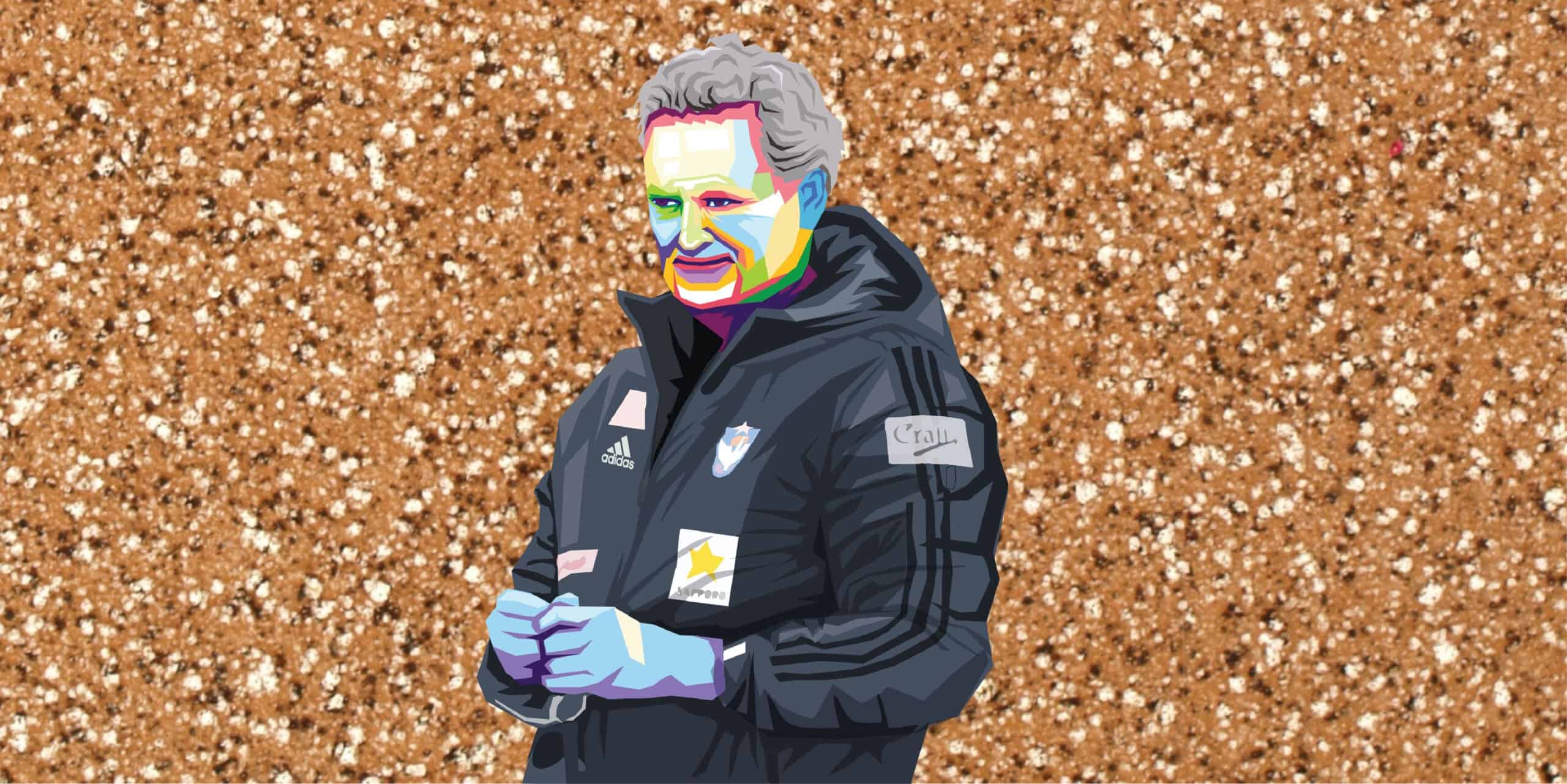



Comments